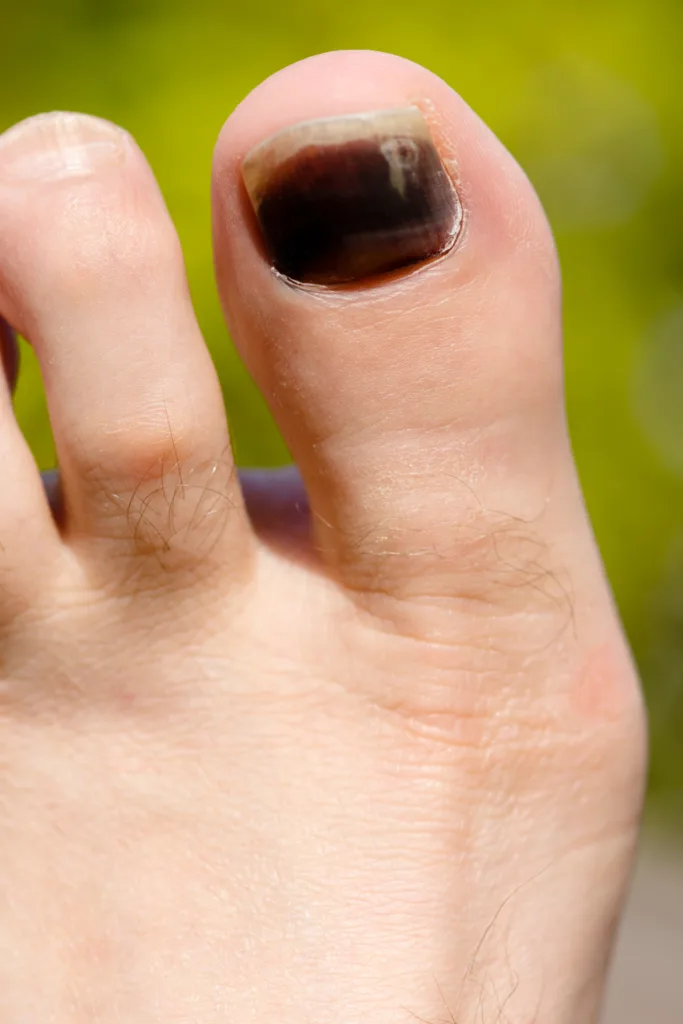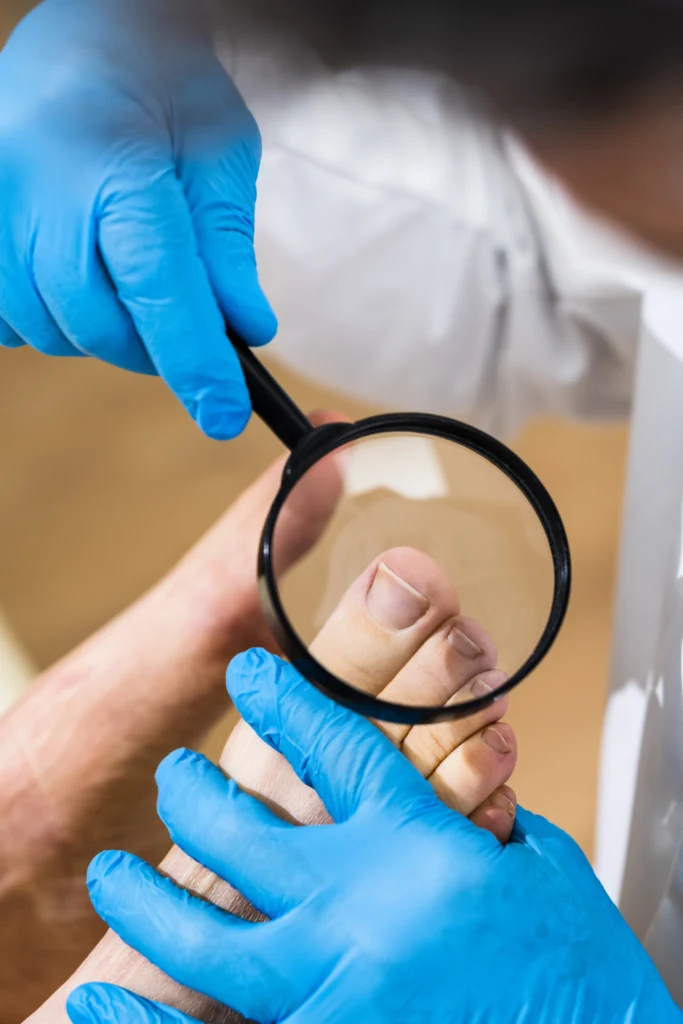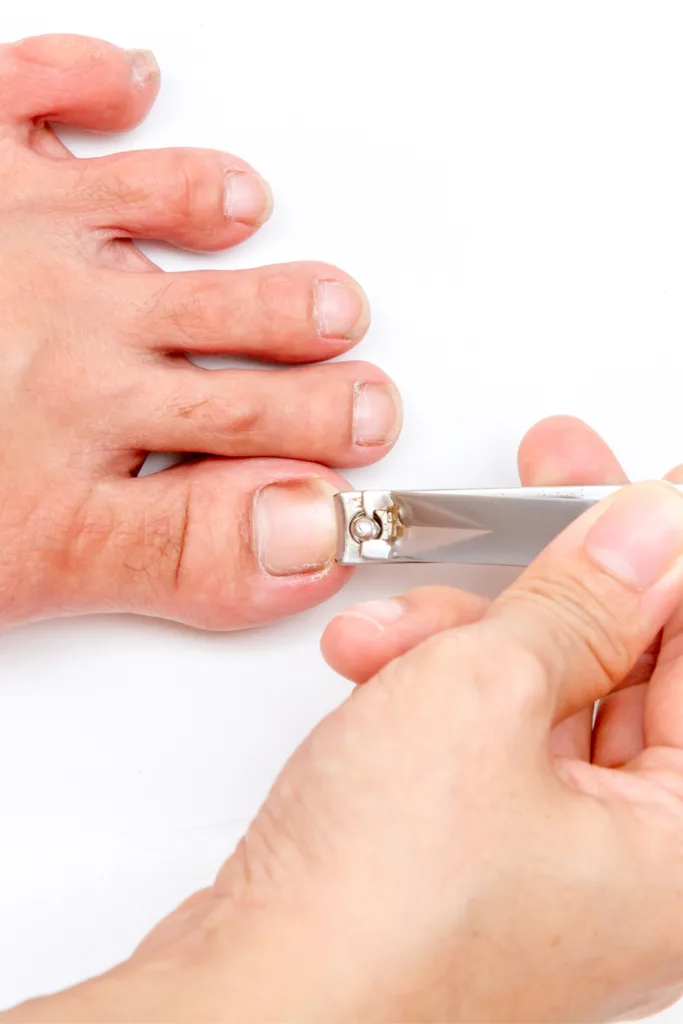Runner’s toe can be an incredibly painful injury, especially if left untreated.
Often referred to as ‘runners toenail’, it is one of the most common injuries in the running community because of the nature of running.
Repeated strain on your foot and repeated rubbing from your running shoe can lead to runners’ toe.
So what are the symptoms of runner’s toe and how can the condition of runner’s toe be treated and prevented for good?
In this guide we’ll explore:
- What is runner’s toe?
- What are the symptoms of runner’s toe?
- What causes runner’s toe?
- Who is at risk of developing runner’s toe?
- How to treat runner’s toe
- 6 ways to prevent runner’s toe
Ready?
Let’s get started!

What is runner’s toe?
Runner’s toe is when your toenail turns black from the repeated stresses of running.
It is commonly caused by your running shoe repeatedly rubbing or slamming against your toe, which leads to blood pooling underneath your nail, making it look black.
The condition is also referred to as: runner’s toenail, black toenail, bruised toenail, subungual hematoma and tennis toe.
Although runner’s toe can affect any toe, it is more commonly found in the large toenail as it sticks out further.
Related: Hip pain after running: 8 causes + how to fix it
What are the symptoms of runner’s toe?
Runner’s toe can be incredibly painful, so the first sign of the condition is often a sharb and throbbing pain on and around your toenail.
You may find it difficult to walk or run as a result of the pain. Some people even find it difficult to wear shoes with the condition.
You may also experience soreness, pressure and swelling around the toe, under the toenail and at the tip of the toe.
When blood starts to collect underneath the toe, will you notice either dark red or black discolouration under some or all of the toenail.
- If the blood is dark red, this means the damage has recently occurred as the blood hasn’t had time to dry yet.
- If the blood is black, this is normally a sign of older damage.
In some cases, the toenail will start to loosen or even fall off.
Related: IT band syndrome: How to fix it + 7 training mistakes to avoid

What causes runner’s toe?
As explained above, runner’s toe is caused by the repeated stress of running on your foot.
Your running shoe rubbing or slamming repeatedly against your toe can cause the condition.
Bleeding underneath the toenail can also be caused by damage to the toenail, for example if you drop something hard or heavy on your toe.
Black toenails can be signs of other diseases and conditions, so it’s worth getting your feet checked out by a healthcare professional if you have any concerns.
These other causes include:
- Fungal infection
- Ingrown toenail
- Subungual exostosis (a benign bone tumour)
- Melanonychia striata (discolouration of the nail)
- Subungual melanoma (a type of skin cancer)
Fungal infection
Fungal infections in the toe are common but can take a long time to treat.
You can get them in your toenails as well as your fingernails.
Runners are susceptible to fungal infections in their toes because they wear running shoes that can often become damp from all the sweat.
The infection can spread to the middle of the toenail, making the nail discoloured and thicker in parts.
In some cases the nail can become brittle and fall off in parts. Sometimes the whole nail can fall off.
Ingrown toenail
An ingrown toenail is a common problem where the nail grows into the toe.
Like runner’s toe, it can be painful and cause swelling and pressure in the toenail.
An ingrown toenail can also cause the toenail to curve into your toe, which could cause infection.
Subungual exostosis
In more serious cases, a black toenail could be the sign of a benign bone tumour (called subungual exostosis).
Subungual exostosis is a bony overgrowth that is permanently attached to the tip of the toe or finger, which then grows upwards into the nail plate causing pain.
The cause of the condition is unknown. However, it is thought that constant irritation of the bone is a causative factor.
Previous trauma and infection may also be causes.
Melanonychia striata
Melanonychia striata is a brown/black discolouration of the nail along the longitudinal band of the nail.
The condition can affect anyone at any age, but it is more prevalent in people with skin of colour.
Subungual melanoma
Subungual melanoma is a rare type of skin cancer that occurs under the nails.
According to Medical News Today, this type of melanoma may be challenging to identify because it often resembles normal bruising of the nails.
One of the key indications of subungual melanoma is “Hutchinson’s sign.” This is when a person has nail pigment that extends onto the skin surrounding the nail.
Related: Overtraining syndrome: 11 symptoms of overtraining when running

Who is at risk of developing runner’s toe?
As its name suggests, it’s mostly runners that are at risk of developing runner’s toe, particularly if you run regularly and wear ill-fitting or worn running shoes.
You can also get the condition if you take part in other activities where stress on the foot is likely:
- Football (soccer)
- Tennis
- Squash
- Rock climbing
In football (soccer) you are required to kick the ball over and over again which can cause damage and stress to your toes.
Kicking the ball too hard can also cause damage, resulting in blood pooling underneath the toenail.
The repeated stop and start nature of sports like squash and tennis can cause your toes to push against your shoes, causing stress to your toe.
Rock climbers are also susceptible to runner’s toe as they are required to continuously press their toes into holds. This pressure can cause stress to the toe.
Related: How to prevent knee pain after running
How to treat runner’s toe
The treatment you receive for runner’s toe will depend on the severity of your symptoms.
If you’re not experiencing a lot of pain, then leave the nail to fall off and it will grow back again.
If you’re in a lot of pain and it is affecting your daily life, then seek treatment from a healthcare professional.
They will conduct a procedure called nail trephination which involves drilling a small hole into the nail plate to release the pressure and drain the blood pooled underneath the nail.
Related: Taste blood when running? 7 causes + how to prevent it

How to prevent runner’s toe
#1 Wear the right running shoes
The right running shoes will do wonders for your running performance, as well as prevent common injuries like runner’s toe.
Make sure you find a pair of running shoes that fit properly, especially around the tip of your foot.
Here’s our checklist finding the right pair of running shoes:
- Shouldn’t feel too tight on the toes. You should half an inch between your big toe and the end of the shoe
- Should be able to wiggle your toes. If your toes are too cramped, you’re more likely to experience issues like runner’s toe.
#2 Keep your toenails in check
Keep your toenails trimmed so they don’t rub on your shoes when walking or running.
The shorter your nails are, the less likely they are to rub and slam against your shoes.
Be careful not to cut them too short though as this is a common cause of ingrown toenails.
#3 Lace up your shoes properly
Surprisingly, how you lace your shoes can affect the amount of pressure placed on your foot.
Opt for a lacing technique that isn’t too tight on your foot and ankle and allows enough room for flexibility.
According to a 2008 study, a firm foot-to-shoe coupling with higher lacing leads to a more effective use of running shoe features and is likely to reduce the risk of lower limb injury.
#4 Wear sweat-wicking socks
When you run your feet become sweaty which can cause bacteria and infection to spread.
Sweaty toes also cause your toes to slip and slide, creating pressure on your toes as they rub against your shoes.
Invest in some high quality, sweat-wicking socks to prevent your toes from sliding in your shoes.
Fabrics like nylon, polyester and bamboo are sweat-wicking and will keep your toes dry and cool.
#5 Wear toe separators
Toe separators (also known as toe spacers) help to prevent and straighten overlapping toes and relieve pain and discomfort.
They are normally made from gel or silicone and conform to your toes to separate them so they don’t overlap.
Separators work to release pressure and realign toes where needed. They also reduce friction and irritation, and address foot and toe pain associated with a variety of ailments and deformities.
It’s worth noting that toe separators should not be worn when running. Instead they help to alleviate the pain and discomfort associated with runner’s toe in between runs.
#6 Wear toe protectors
Toe protectors work by surrounding and cushioning your toes in a soft material, usually silicon gel, to protect your toes from stress, pressure and friction.
They can be worn on runs, so they are great to wear to help relieve any discomfort that you may already be experiencing on your runs.
- 5 things I wish I’d known before returning to running - March 3, 2024
- Running 20 minutes a day: Benefits + how to start - January 27, 2024
- How to run your first 2 hour half marathon - January 16, 2024
